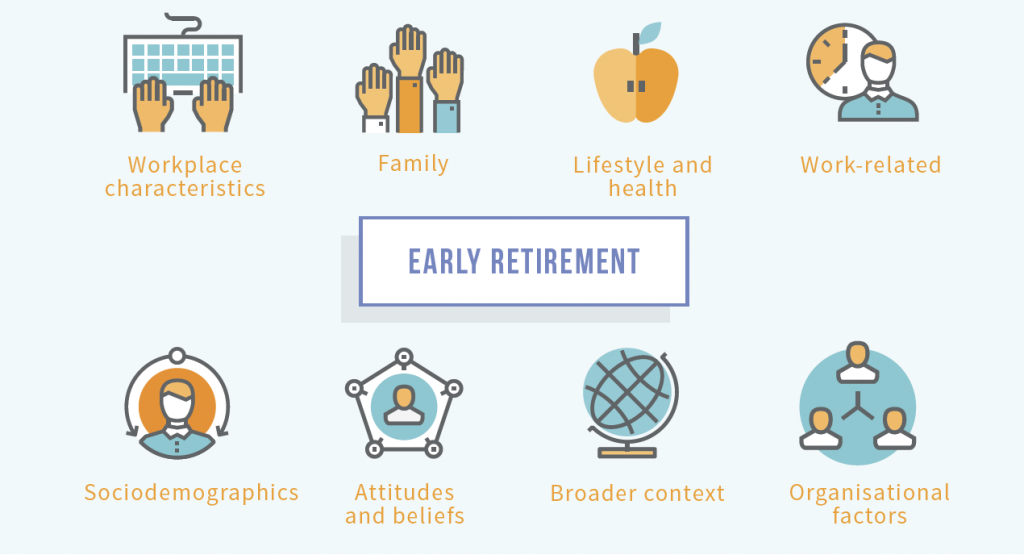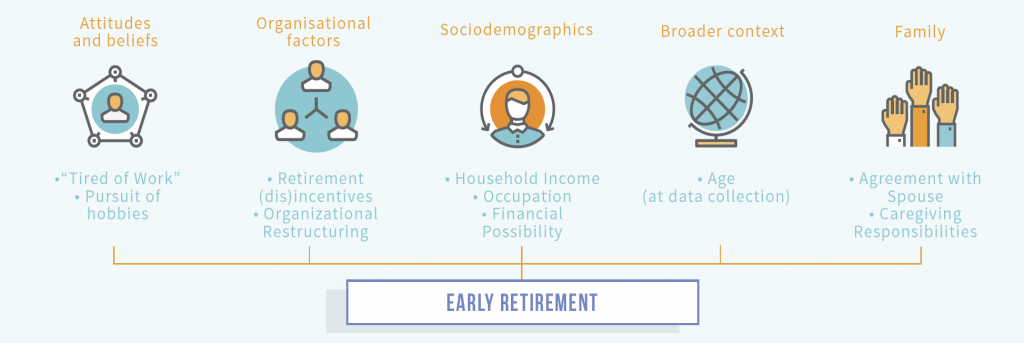Dr Sarah Hewko – Investigating Health Professionals’ Retirement Decision-Making
The availability of skilled health practitioners is fundamental to the health of a nation. Unfortunately, many countries experience shortages of healthcare professionals. Shortages typically result when too few choose to enter the health professions and when too many exit the health professions, whether to pursue an alternate career or to retire. Dr Sarah Hewko, based at the University of Prince Edward Island, is conducting valuable research into the reasons why health professionals retire earlier than planned.
Ageing Populations and Healthcare
Even before the COVID-19 pandemic, health systems around the world were struggling to cope with increasing demands for medical care. In keeping with a trend that first presented in developed countries, nearly all countries are now having to meet the needs of an increasingly ageing population. This has significant implications for healthcare, as older adults tend to access health services more frequently. Furthermore, declining birth rates have led to there being fewer new entrants into the labour market. In a nutshell, more people are needing healthcare but there are fewer skilled professionals available to provide it.
The availability of skilled health practitioners is affected both by the number of individuals who enter the health professions (which depends, at least in part, on the availability of places in profession-specific training programs) and by the number of individuals who leave those professions, whether to retire or to pursue alternate employment.

Healthcare Professional Shortages Across the World
The Global Health Workforce Alliance and the World Health Organization recently reported a global deficit of skilled healthcare professionals of around 7.2 million – and this number is increasing. The consequences of such shortages vary but include increased costs of healthcare, increased wait times for health services, and longer working hours for existing staff.
Shortages in healthcare are present across professions, including in medicine, nursing, and the allied health professions. Allied health professionals (AHPs) include, among others, dietitians, pharmacists, physiotherapists and speech and language therapists. Unfortunately, the causes of workforce shortages within the allied health professions are under-researched. In particular, little is known about the factors influencing retirement in these professional groups.
Researching Retirement
Dr Sarah Hewko, Assistant Professor at the University of Prince Edward Island, has been researching how healthcare professionals approach retirement decision-making retirement for several years. In a key study, Dr Hewko utilised baseline data from the Canadian Longitudinal Study on Aging (CLSA). The CLSA is a national study which will follow approximately 50,000 Canadians, aged between 45 and 85 at the time of recruitment for 20 years. The CLSA is one of many databases across the globe tracking population-level outcomes of ageing.
Although the average age of retirement in Canada is 64, Dr Hewko found that AHPs were retiring, on average, between 56 and 60 years old (depending on profession) with RNs retiring at 58 years old. With early retirement defined as retirement below 65 years of age, Dr Hewko found that not only were many AHPs and RNs retiring ‘early’ but, in some cases, they were retiring earlier than they had planned. Her next step was to identify the reason(s) why.
Dr Hewko and her colleagues began by reviewing the available published research. From this, they developed a conceptual model of the factors most often reported to affect early retirement decision making in RNs and AHPs. A conceptual model is essentially a visual representation of key factors (or variables) proposed to influence an outcome – in this case, early retirement.

Figure 1: Conceptual model of early retirement among registered nurses and allied health professionals.
Conceptualising Early Retirement
In Dr Hewko and her colleagues’ conceptual model, factors proposed to affect early retirement were identified based on previously published findings. These fell into eight broad categories (as shown in Figure 1).
Workplace characteristics included whether older workers were recognised and valued in the workplace, the frequency of structural and/or technological change, and the flexibility of working hours. Age-related stigma and discrimination can be characteristic of a workplace and may cause health professionals to retire early if, as they age, they come to view the workplace as an increasingly unwelcome space. Other work-related factors included work schedule (e.g., days/nights, rotating shifts), how long the individual had been working over their entire career, and how long they had been working for the current organisation.
Sociodemographic factors, such as educational level, financial security and childcare responsibilities also featured in the model. For example, healthcare professionals who perceive themselves as financially secure may decide to retire early as they can afford to support themselves without working. The related category of family incorporated factors such as whether one’s partner was retired, the partner’s health status, and caregiving responsibilities, such as caring for elderly parents.
Lifestyle and health-related factors are also critical to decisions surrounding retirement in later life. Through the process of ageing, our health may begin to deteriorate to the point where working is no longer practical. As such, physical and psychological health status, level of physical activity and the presence of any disability will affect an individual’s ability to work and be a significant contributing factor to the decision to retire. Societal expectations may also lead individuals to retire early (or earlier than planned) as others begin to perceive them as ‘infirm’ or less physically capable (even if their performance remains unchanged).
A healthcare professional’s attitudes and beliefs around work and retirement also influence retirement decisions. Job satisfaction is a key element of this, as is the individual’s level of commitment to the organisation and/or their occupation. Personal views of retirement are also important, alongside an individual’s desire to have more time for leisure activities.
Across all occupations, the broader context of age, within the context of ‘generations’, is a much-discussed factor that may influence the timing of retirement. The generation known as ‘baby boomers’ (born between 1946 and 1964) reached 65 years beginning in 2011 and the subsequent ‘generation x’ is the next to face retirement.
Another factor was the ‘location of residence’, which is associated with differences in legislation, taxation and labour laws across municipalities, provinces, states and districts. Characteristics and policies of the employing organisation also affect the decision to retire. Incentives to leave for early retirement may be featured during planned organisational restructuring, increasing the appeal of early retirement for the individual.
We can see that many factors proposed in the model interact with others, both within each category and across categories. For instance, the flexibility of working hours (which falls under ‘workplace characteristics’) may affect whether or not a healthcare professional decides to continue working alongside caring for older family members (a factor considered under the category of ‘family’).
The conceptual model of early retirement was validated for clarity, logic and comprehensiveness by Dr Hewko through a series of interviews with Canadian RNs and AHPs. Interviewees confirmed that the model was clear, logical and included all the factors relevant to early retirement among health professionals.
Application of the Conceptual Model to Data
Following the validation of the model, Dr Hewko tested its ability to account for early retirement in RNs and AHPs, drawing again on data from the CLSA. Using a pared down version of the model (see Figure 2), the categories of ‘attitudes and beliefs’, ‘organisational factors’, ‘sociodemographics’, ‘age’ (broader context) and ‘family’ were able, to some extent, to (statistically) explain the real-world data for both RNs and AHPs. This demonstrated the utility of the model.
Of the specific factors of interest, Dr Hewko identified that both RNs and AHPs reported organisational restructuring as influencing their decision to retire early. For RNs, further significant factors including early retirement being financially viable, profession of a desire to stop working, and caregiving responsibilities.

Figure 2: Analytic model of early retirement among registered nurses and allied health professionals. Adapted from S Hewko, et al., The early retiree divests the health workforce: a quantitative analysis of early retirement among Canadian Registered Nurses and allied health professionals, Human Resources for Health, 2019, 17, 49, under the Creative Commons Attribution 4.0 International License.
Proposed Avenues of Change
Given the urgent shortage of healthcare workers and the healthcare requirements of the increasingly ageing population, there is a clear need to retain healthcare workers in the workforce for as long as possible. Extending the work-lives of RNs and AHPs by an average of even 6 months each could have a significant impact on national workforce shortages and the sustainability of health systems.
Organisational restructuring often occurs in response to budget restrictions and can involve the elimination of certain roles, as well as changes to reporting structures. Older workers may be more affected by restructuring as they tend to be on higher salary bands and therefore cost organisations more. Older workers, particularly those who have been with the employer for a long time, are significant sources of organisation-specific historical knowledge and are of significant value in the efficient and effective training of newly hired professional staff and student health professionals. As one of the few work-specific factors identified as influential to retirement decision-making by both RNs and AHPs, it is, fortunately, one of the easiest to address.
Dr Hewko recommends effective and frequent communication throughout organisational restructuring as a method to lessen uncertainty that might contribute to healthcare professionals opting for early retirement. She also recommends stronger collaborations between trade unions and hospital management to avoid adverse impacts resulting from restructuring.
Critically, for RNs, caregiving responsibilities were associated with 7.2 times greater likelihood of early retirement. This is perhaps unsurprising given that women are, in addition to their vocation, likely to also fill the stereotypically nurturing roles of mother, wife and daughter. Noting this, Dr Hewko argues for greater implementation of caregiver-friendly policies to encourage healthcare professionals to remain in the workforce while caregiving and to facilitate penalty-free short-term exits from employment to fulfil time-limited needs for full-time caregiving, such as during cancer treatment regimes, post-surgery or at the end-of-life.
Dr Hewko’s work has highlighted the interrelated and often complex factors that contribute to a healthcare professional’s decision to retire at a certain point in their lives. With support from the Ireland Canada University Foundation, she will be travelling to Ireland in the coming year to conduct analyses looking at similarities and differences in retirement decision making among registered nurses (RNs) and AHPs in Ireland and Canada.
As such, Dr Hewko’s further research will continue to provide knowledge that will be key to building and maintaining sustainable healthcare systems. Through understanding the reasons why people retire early, efforts can more effectively be focused on retaining more healthcare professionals for a longer period of time and addressing health workforce shortages in Canada and beyond.
Reference
https://doi.org/10.33548/SCIENTIA629
Meet the researcher

Dr Sarah Hewko
Department of Applied Human Sciences
University of Prince Edward Island
Charlottetown
Prince Edward Island
Canada
Dr Sarah Hewko obtained her Master of Health Administration from the University of British Columbia before going on to the University of Alberta to complete a PhD in Nursing in 2018. Trained as a dietitian, she has worked as a manager of clinical dietitians and maintains a small, specialised practice where she treats clients struggling with disordered eating. Dr Hewko currently holds the position of Assistant Professor in the Department of Applied Human Sciences at the University of Prince Edward Island. In her research, she focuses on dietetics, allied health workforce planning, and healthcare administration. Dr Hewko’s work has been published in Human Resources for Health, Healthcare Policy, Leadership in Health Services and Health Policy (among other peer-reviewed journals). In addition, she has presented her research at conferences across Europe and North America.
CONTACT
E: shewko@upei.ca
W: https://www.upei.ca/profile/sarah-hewko
Instagram lab: hewkohealthhrresearch
KEY COLLABORATORS:
Greta Cummmings, PhD RN, Professor and Dean of Nursing, University of Alberta
Carole Estabrooks, PhD, RN, Professor and Canada Research Chair in Knowledge Translation
Trish Reay, PhD, Professor and Associate Dean (Research), Alberta School of Business
FUNDING
Dobbin Atlantic Scholarship Programme 2020
Ireland Canada University Foundation
FURTHER READING
SJ Hewko, A Oyesegun, SD Clow, C van Leeuwen, High turnover in clinical dietetics: A qualitative analysis, BMC Health Services Research, 2021, doi:10.1186/s12913-020-06008-5
SJ Hewko, T Reay, CA Estabrooks, GG Cummings, Retirement decision-making among Registered Nurses and allied health professionals: A descriptive analysis of Canadian Longitudinal Study on Aging data, Healthcare Policy, 2019, 15(2), 20–27.
SJ Hewko, T Reay, CA Estabrooks, GG Cummings GG, The early retiree divests the health workforce: A quantitative analysis of early retirement among Canadian Registered Nurses and allied health professionals, Human Resources for Health, 2019, 17, 49.
SJ Hewko, T Reay, CA Estabrooks, GG Cummings, Conceptual models of early and involuntary retirement among Canadian Registered Nurses and allied health professionals, Canadian Journal on Aging, 2018, 37(3), 294–308.
SJ Hewko, GG Cummings, Performance management in healthcare: A critical analysis, Leadership in Health Services, 2016, 29(1), 52–68.

Want to republish our articles?
We encourage all formats of sharing and republishing of our articles. Whether you want to host on your website, publication or blog, we welcome this. Find out more
Creative Commons Licence
(CC BY 4.0)
This work is licensed under a Creative Commons Attribution 4.0 International License. 
What does this mean?
Share: You can copy and redistribute the material in any medium or format
Adapt: You can change, and build upon the material for any purpose, even commercially.
Credit: You must give appropriate credit, provide a link to the license, and indicate if changes were made.
More articles you may like
Dr Lifei Wang | Can Species Distribution Models Inform Us About Future Ecosystems?
The world is buzzing with news about how human activities and climate shifts are reshaping our ecosystems. Have you ever wondered how life will adapt to this rapidly changing world? Ecologists might be able to predict how different species will live in future using computer simulations. Dr Lifei Wang at the University of Toronto Scarborough investigates how different stimulations work under varying conditions to provide new insights into what may lie ahead.
Dr Yong Teng | Improving the Outlook for Head and Neck Cancer Patients
Dr Yong Teng at the Emory University School of Medicine is working with colleagues to overcome the high mortality of individuals diagnosed with cancers affecting the head and neck. One of his approaches is based on understanding the particular mechanisms of the ATAD3A gene, which new insights suggest are closely related to cancers affecting the head and neck.
Dr Tsun-Kong Sham – Dr Jiatang Chen – Dr Zou Finfrock – Dr Zhiqiang Wang | X-Rays Shine Light on Fuel Cell Catalysts
Understanding the electronic behaviour of fuel cell catalysts can be difficult using standard experimental techniques, although this knowledge is critical to their fine-tuning and optimisation. Dr Jiatang Chen at the University of Western Ontario works with colleagues to use the cutting-edge valence-to-core X-ray emission spectroscopy method to determine the precise electronic effects of altering the amounts of platinum and nickel in platinum-nickel catalysts used in fuel cells. Their research demonstrates the potential application of this technique to analysing battery materials, catalysts, and even cancer drug molecules.
Dr Michael Cherney – Professor Daniel Fisher | Unlocking Woolly Mammoth Mysteries: Tusks as Hormone Time Capsules
The impressive tusks found on proboscideans (the order of mammals that includes elephants, woolly mammoths, and mastodons) are like time capsules, preserving detailed records of their bearers’ lives in the form of growth layers and chemical traces. Frozen in time for thousands of years, these layers can unlock secrets about the lives of long-extinct relatives of modern elephants. Dr Michael Cherney and Professor Daniel Fisher from the University of Michigan used innovative techniques to extract and analyse steroid hormones preserved in woolly mammoth tusks. This ground-breaking work opens new avenues for exploring the biology and behaviour of extinct species.




